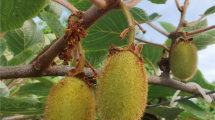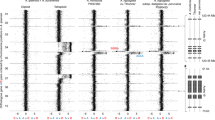Abstract
The genetic origin of kiwifruit (Actinidia deliciosa var.deliciosa) was studied using phylogenetic analysis of DNA sequences derived from the polygalacturonase gene. Results indicate that hexaploid kiwifruit had an allopolyploid origin with the diploidA. chinensis contributing one genome (genome A) and another (as yet unidentified) diploid species contributing a second genome (genome B). The results leave open the question of whether a third, distinct species contributed to the hexaploid kiwifruit genome. A tetraploid race ofA. chinensis is also suggested to be allopolyploid containing genomes A and B.
Similar content being viewed by others
References
Anderberg, A. A., 1992: The circumscription of theEricales, and their cladistic relationships to other families of “higher” dicotyledons. — Syst. Bot.17: 660–675.
Atkinson, R. G., 1993: Molecular approaches to horticultural crop improvement. — Ph.D. Thesis, University of Auckland.
—, Gardner, R. C., 1993: A polygalacturonase gene from kiwifruit (Actinidia deliciosa). — Pl. Physiol.103: 669–670.
Crowhurst, R. N., Gardner, R. C., 1991: A genome-specific repeat sequence from kiwifruit (Actinidia deliciosa var.deliciosa). — Theor. Appl. Genet.81: 71–78.
—, Lints, R., Atkinson, R. G., Gardner, R. C., 1990: Restriction fragment length polymorphisms in the genusActinidia (Actinidiaceae). — Pl. Syst. Evol.172: 193–203.
Devereux, J., Haeberli, P., Smithies, O., 1984: A comprehensive set of sequence analysis programmes for the VAX. — Nucl. Acids Res.12: 387–395.
Ferguson, A. R., 1990a: The genusActinidia. — InWarrington, I. J., Weston, G. C., (Eds): Kiwifruit: science and management, pp. 15–35. — Auckland: New Zealand Society for Horticultural Science Inc., Ray Richards Publisher.
—, 1990b: Botanical nomenclature:Actinidia chinensis, Actinidia deliciosa, andActinidia setosa. — InWarrington, I. J., Weston, G. C., (Eds): Kiwifruit: Science and management, pp. 36–58. — Auckland: New Zealand Society for Horticultural Science Inc., Ray Richards publisher.
Grierson, D., Tucker, G. A., Keen, J., Ray, J., Bird, C. R., Schuch, W., 1986: Sequencing and identification of a cDNA clone for tomato polygalacturonase. — Nucl. Acids Res.14: 8595–8603.
Janssen, B.-J., Gardner, R. C., 1993: The use of transient GUS expression to develop anAgrobacterium-mediated gene transfer system for kiwifruit. — Pl. Cell Rep.13: 28–31.
Kron, K. A., Chase, M. W., 1993: Systematics of theEricaceae, Empetraceae, Epacridaceae and related taxa based uponrbcL sequence data. — Ann. Missouri Bot. Gard.80: 735–741.
Lee, E., Speirs, J., Gray, J., Brady, C. J., 1990: Homologies to the tomato endopolygalacturonase gene in the peach genome. — Pl. Cell Environm.13: 513–521.
Liang, C.-F., 1983: On the distribution ofActinidia. — Guihaia3: 229–248. (In Chinese.)
—, Ferguson, A. R., 1986: The botanical nomenclature of the kiwifruit and related taxa. — New Zealand J. Bot.24: 183–184.
McNeilage, M. A., Considine, J. A., 1989: Chromosome studies in someActinidia taxa and implications for breeding. — New Zealand J. Bot.27: 71–81.
Sambrook, J., Fritsch, E. F., Maniatis, T., 1989: Molecular cloning: a laboratory manual, 2nd edn. — Cold Spring Harbor: Cold Spring Harbor Laboratory Press.
Sanger, F., Nicklen, S., Coulsen, A. R., 1977: DNA sequencing with chain-terminating inhibitors. — Proc. Natl. Acad. Sci. USA74: 5463–5467.
Soltis, D. E., Soltis, P. S., 1993: Molecular data and the dynamic nature of polyploidy. — Crit. Rev. Pl. Sci.12: 243–273.
Swofford, D., 1993: PAUP: phylogenetic analysis using parsimony 3.1.1. — Smithsonian Institution, Washington, D.C.
Watanabe, K., Takahashi, B., Shirato, K., 1990: Chromosome numbers in kiwifruit (Actinidia deliciosa) and related species. — J. Jap. Soc. Hort. Sci.58: 835–840.
Xiong, Z., 1992: Chromosome studies on cultivated chinese gooseberry. — Guihaia12: 79–82. (In Chinese.)
Yan, G. J., Ferguson, A. R., McNeilage, M. A., 1994: Ploidy inActinidia chinensis. — Euphytica78: 175–183.
Author information
Authors and Affiliations
Corresponding author
Rights and permissions
About this article
Cite this article
Atkinson, R.G., Cipriani, G., Whittaker, D.J. et al. The allopolyploid origin of kiwifruit,Actinidia deliciosa (Actinidiaceae). Pl Syst Evol 205, 111–124 (1997). https://doi.org/10.1007/BF00982801
Received:
Revised:
Accepted:
Issue Date:
DOI: https://doi.org/10.1007/BF00982801




